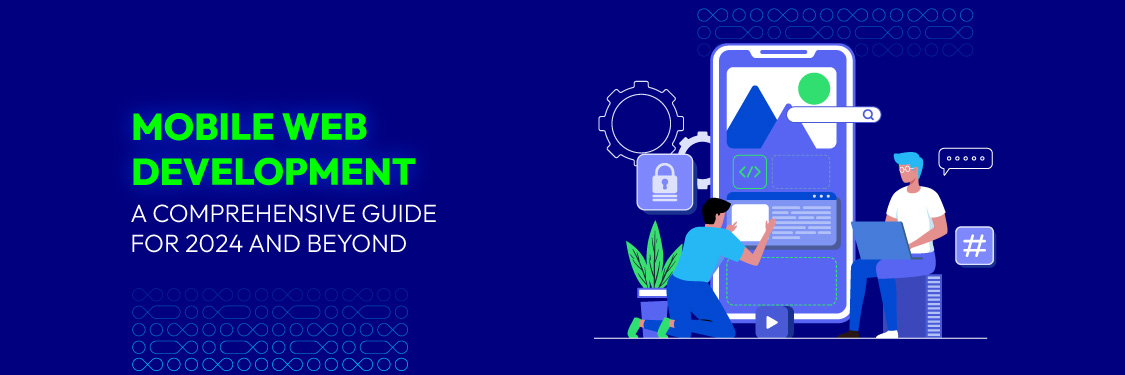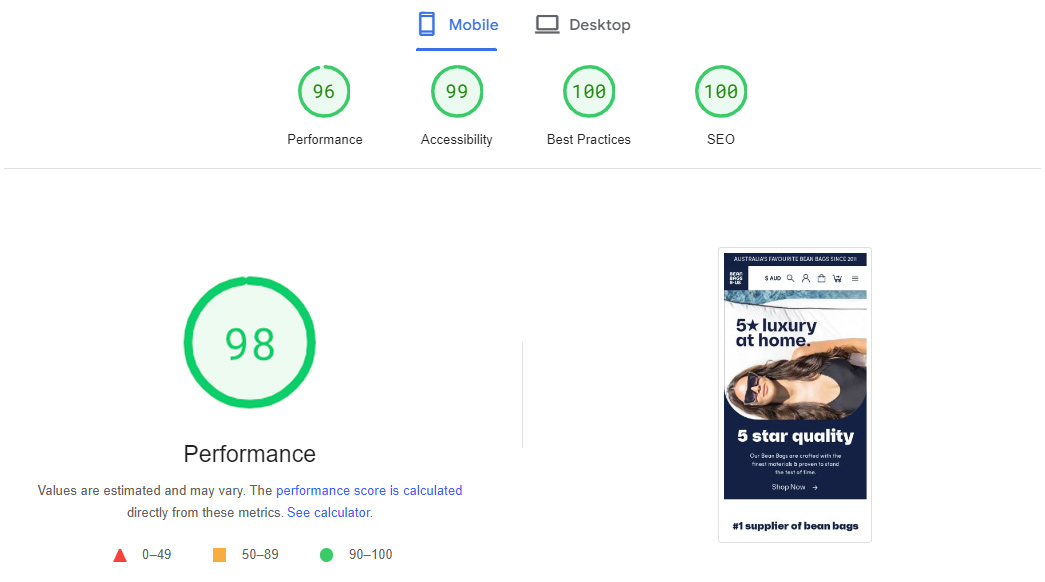Mobile Web Development: A Comprehensive Guide for 2024 and Beyond
Summer Nguyen | 07-25-2024

Did you know that 92.3% of users use their mobile phones to surf the internet? Without mobile optimization, your website is missing out on a significant number of potential visitors. With more users than ever accessing the internet through their smartphones and tablets, mobile web development has become an essential skill for businesses and developers alike.
In this post, we’ll dive into the world of mobile web development, exploring the techniques, tools, and best practices that will help you create seamless and engaging experiences for your mobile audience.
What is Mobile Web Development?
Mobile web development means making websites and online experiences that are optimized for mobile devices. This involves using techniques like responsive design and prioritizing user experience (UX) to ensure that content is easily accessible, navigable, and enjoyable on smaller screens.

There are a few different approaches you can take when developing for the mobile web:
- Responsive Web Design (RWD): This is the most common and recommended approach. It involves using flexible layouts, images, and CSS media queries to make a single website adjust to different screen sizes.
- Separate Mobile Website: This involves creating a completely separate website specifically for mobile devices. While it offers more customization, it can be harder to maintain two separate sites.
- Progressive Web Apps (PWAs): These are web applications that feel and function like native apps. They provide features such as offline use, notifications, and easy access from the home screen.
- Hybrid Apps: These are made with web tools like HTML, CSS, and JavaScript but work like regular apps. They can access phone features like the camera and GPS but might not work as smoothly as fully native apps.
Mobile App Development vs. Mobile Web Development
To begin our exploration of mobile development, let’s distinguish between mobile apps and the mobile web. Both cater to users on smartphones and tablets, but they involve distinct development processes with unique strengths and weaknesses. For companies that want the advantages of a dedicated app but need to manage costs and complexity, it often makes sense to outsource mobile app development to a trusted partner.
- Mobile App Development: This involves creating applications specifically designed to be downloaded and installed on a user’s mobile device. These apps can be built for specific operating systems (iOS or Android) and often leverage device features like cameras, GPS, and push notifications.
- Mobile Web Development: This focuses on creating websites optimized for viewing on mobile devices. These sites are accessed through web browsers and adapt their layout and functionality to fit different screen sizes and resolutions.
| Feature | Mobile App Development | Mobile Web Development |
|---|---|---|
| User Experience | Often provides a more immersive and interactive experience, with smoother animations and access to device-specific features. | Can offer a consistent experience across platforms but may be limited in terms of interaction and access to device features. |
| Offline Access | Many apps work offline so users can still see content even without the internet | Typically requires an internet connection to function, although some content may be cached for offline viewing. |
| Distribution | Distributed through app stores (Apple App Store, Google Play Store), which can offer visibility but involve approval processes. | Easily accessible through web browsers without needing to download or install anything. |
| Development Cost | Generally more expensive due to the need for platform-specific development and app store submission fees. | Often more cost-effective as a single codebase can be used for multiple platforms. |
| Updates | Require users to download and install updates, which can lead to fragmentation if not all users update. | Updates can be deployed instantly to the server so everyone gets the latest version. |
| Discoverability | Can be discovered through app store searches and featured lists but may be harder to find if not well-promoted. | Can be easily found through search engines if optimized for relevant keywords. |
By considering these factors closely, you can decide if mobile app development or mobile web development is the best fit for your specific project and goals.
Free 1-1 consultation: Website Development Service
- Responsive design optimized for every device
- All-in-one website development solutions
- Lightning-fast onboarding in just 48 hours
- Free 2-month support after the project

The Importance of Mobile Web Development
As we explored previously, mobile apps offer many advantages but their development can be costly and time-consuming. In contrast, mobile web development offers a more budget-friendly alternative, allowing businesses and individuals to quickly establish a presence on the mobile web. Let’s discover why mobile web development is important for most businesses!
SEO
Today, nearly 60% of global web traffic comes from mobile devices. As a result, Google primarily uses the mobile version of a website’s content, crawled with the smartphone Googlebot, for indexing and ranking. This approach is referred to as mobile-first indexing.
If your site isn’t optimized for mobile, you’re less likely to show up in search results, which means fewer potential customers will find you. Mobile web development ensures your site meets Google’s mobile-first indexing criteria, boosting your visibility and organic traffic.

User Experience
Mobile users have limited patience for slow-loading or difficult-to-navigate websites. A poor mobile experience will quickly drive them away. In addition, 62% of users are unlikely to buy from a brand if they had a bad mobile experience.
Focusing on mobile web development enables you to create fast, intuitive, and engaging experiences that keep users on your site, interact with your content, and ultimately, convert into customers.
Mobile-friendly websites are built to look good on smaller screens and to load quickly, making them easy to use and offering benefits such as:
- Increased time spent on site
- More pages viewed per session
- Lower bounce rates
Conversion Rates
A positive mobile experience directly impacts your bottom line. Studies have shown that mobile-optimized websites enjoy significantly higher conversion rates for everything from sales and sign-ups to inquiries and downloads.
According to ThinkWithGoogle, 63% of smartphone users will buy from businesses that recommend products they might like on their mobile sites or apps. By investing wisely in mobile web development and harnessing its potential, your business can boost orders and drive revenue growth.
Frameworks and Tools for Mobile Web Development
Creating a responsive, mobile-friendly website can seem daunting, but thankfully, there are powerful tools and frameworks designed to simplify the process. Let’s explore some popular options that can streamline your mobile web development journey!
CSS Frameworks
CSS frameworks provide pre-built styles and components that are optimized for mobile responsiveness. They save you time and effort by handling complex layout issues and cross-browser compatibility. Some widely-used CSS frameworks include:
- Bootstrap: A comprehensive framework known for its grid system, extensive component library, and ease of use.
- Foundation: Similar to Bootstrap, Foundation offers a robust grid system and versatile components. It’s known for its customization options.
- Tailwind CSS: A utility-first CSS framework that gives you granular control over styling and allows for highly tailored designs.

Mobile Testing Tools
Before launching your mobile website, thorough testing is crucial. Mobile testing tools enable you to simulate different devices, screen sizes, and operating systems, ensuring your site looks and functions flawlessly across a wide range of mobile devices. Popular options include:
- BrowserStack: A cloud-based platform offering access to thousands of real devices for comprehensive testing.
- LambdaTest: Another cloud-based tool with a vast device library, allowing you to test your site’s responsiveness and performance.
You might be interested in: Mobile Website Speed Test: Ways To Boost & 7 Test Tools
Emulators and Simulators
Emulators and simulators replicate the software and hardware environment of mobile devices on your computer. While they don’t perfectly mirror real-world conditions, they offer a convenient way to test your website during development. Examples include:
- Android Studio Emulator: Simulates Android devices, providing a virtual environment for testing Android-specific features.
- Xcode Simulator: Simulates Apple devices (iPhone, iPad) for testing iOS-specific functionality.
The right tools for your project depend on your needs, budget and team’s expertise. Explore various mobile web frameworks and testing tools to streamline development, ensure cross-device compatibility, and enhance user experience. However, even the best tools can’t make up for poor design or lack of optimization. Prioritize a user-centric approach and adhere to best practices in mobile web development.
Key Principles of Mobile Web Development
To create a truly user-friendly mobile experience, there are a few fundamental principles to keep in mind:
- Performance First: Mobile users demand speed. Prioritize optimizing your website for performance by compressing images, minifying code, and using techniques like lazy loading to ensure a snappy experience.
- Touch-Friendly Design: Forget the mouse; mobile users navigate with their fingers. Design for touch interaction by using larger buttons and links, ample spacing between elements, and clear tap targets to avoid accidental clicks.
- Prioritize Readability: Use a legible font size (at least 16px for body text), appropriate line height, and enough contrast between the text and the background to make it easy to read.
- Easy Navigation: Mobile menus should be simple and easy to use with one hand. Use a hamburger menu to keep options neat and sticky headers for easy access to essential links.
- Mobile-Specific Features: Take advantage of mobile capabilities like geolocation (to provide location-specific content or services) and click-to-call functionality (making it easy for users to contact you).
Best Practices for Mobile Web Development
Beyond the fundamental principles, here are actionable best practices to elevate your mobile web development game:
Performance Optimization
- Image Optimization: Use tools like TinyPNG or ImageOptim to reduce file sizes without losing quality. Choose the right image formats (WebP for modern browsers, JPEG for photos, PNG for graphics).
- Code Minification: Remove unnecessary characters (whitespace, comments) from your HTML, CSS, and JavaScript files to reduce file size and improve loading speed. Use tools like Google PageSpeed Insights or Lighthouse to identify and address performance bottlenecks.

- Lazy Loading: Load images and videos only when they appear on the screen, instead of all at once when the page opens. This can make your page load faster at the start.
- Caching: Leverage browser caching to store static assets, reducing the need to download the same resources repeatedly.
Design and Usability
- Visual Hierarchy: Guide users’ eyes by using clear visual cues like size, color, and contrast to prioritize important elements.
- Responsive Design: Ensure your site adapts smoothly to different screen sizes by using a responsive framework or implementing responsive design techniques.
- Minimalist Design: Keep things simple by focusing on important content and features. Use empty space wisely to make the page easier to read and look clean.
- Call-to-Action (CTA) Placement: Strategically place CTAs where they are easily visible and accessible. Use contrasting colors and clear language to make them stand out.
- Mobile-First Approach: Design with mobile in mind from the beginning, rather than trying to adapt a desktop site for mobile later.
Content and Functionality
- Concise Content: Mobile users prefer short, scannable content. Get to the point quickly and avoid excessive text.
- Touch-Friendly Forms: Optimize forms for mobile input by using large input fields, clearly labeled buttons, and avoiding drop-down menus.
- Mobile Payment Options: If you sell products or services, offer mobile-friendly payment options like Apple Pay or Google Pay.
- Accessible Design: Make sure your website is usable by individuals with disabilities by adhering to Web Content Accessibility Guidelines (WCAG).
Testing and Optimization
- Test on Real Devices: Test your website on various devices and browsers to find and fix issues. Use emulators and physical devices to ensure cross-device compatibility and a consistent user experience.

- Monitor Analytics: Use tools like Google Analytics to track mobile user behavior and gather feedback. Analyze this data to identify areas for improvement and make data-driven decisions to enhance the mobile experience.
- Keep Up with Trends: Stay updated on the latest mobile web development trends and technologies. Continuous learning and adaptation to new standards will help maintain a modern and efficient mobile presence.
By adhering to these best practices, you’ll create a mobile web experience that not only meets but exceeds user expectations, leading to increased engagement, conversions, and ultimately, business success.
Latest Trends in Mobile Web Development
Mobile web development is an ever-evolving field, with new trends constantly emerging. Here are some of the latest trends shaping the future of mobile web development in 2024 and beyond:
- Progressive Web Apps (PWAs): PWAs mix web and app experiences, working like an app in your browser. They load quickly, work offline, send notifications, and appear on your home screen without needing to download anything from an app store. PWAs are getting more popular because they offer the best of both worlds: easy access from the web and features like an app.
- Dark Mode: Dark mode has gained immense popularity across devices and platforms. It reduces eye strain, improves battery life on OLED screens, and offers a sleek aesthetic appeal. Implementing dark mode on your mobile website can enhance the user experience and cater to a growing preference among users.
- Voice User Interfaces (VUIs): Voice search and voice commands are becoming more prevalent, especially on mobile devices. Integrating VUIs into your mobile website can provide a convenient and accessible way for users to interact with your content, search for products, or navigate through your site.
- Accelerated Mobile Pages (AMP): AMP is an open-source project that helps web pages load super fast on mobile devices. AMP pages are stripped down to the essentials, resulting in lightning-fast loading times, particularly on slower connections. This can greatly enhance user experience and lower bounce rates.
- Machine Learning (ML) and Artificial Intelligence (AI): ML and AI are revolutionizing various aspects of web development, including mobile. Chatbots powered by AI can enhance customer service, while ML algorithms can personalize content and recommendations based on user behavior. Incorporating these technologies can make your mobile website more intelligent and engaging.
- Augmented Reality (AR): AR is being increasingly used in mobile web development, particularly in e-commerce, real estate, and gaming. It allows users to interact with digital elements in the real world, providing immersive experiences directly from their browsers.
- Enhanced Security Measures: Mobile security is paramount, especially with the increasing number of transactions and sensitive information being shared on mobile devices. Implementing robust security measures like HTTPS encryption, strong passwords, and two-factor authentication is crucial to protect your users’ data and build trust.
- Microinteractions: Subtle animations and interactive elements can add a touch of delight and polish to your mobile website. Microinteractions like hover effects, button animations, and loading animations can make the user interface more engaging and enjoyable.
- 5G Connectivity: The rollout of 5G networks is set to revolutionize mobile web experiences. With faster speeds and lower latency, 5G will enable richer content, seamless video streaming, and more interactive features on mobile websites.
By keeping up with these trends and adding them to your mobile web development strategy, you can create a top-notch mobile experience that goes beyond what users expect.
Conclusion
In conclusion, mobile web development is no longer just a trend but a necessity in today’s digital landscape. More and more people are using phones to go online, so making websites that work well on all screen sizes is important for businesses to reach everyone. Don’t let your business get left behind – invest in mobile web development and unlock the full potential of the mobile revolution.






![Top 20+ Must-have Shopify Apps for 2025 [Free & Paid] - Mageplaza](https://cdn2.mageplaza.com/media/blog/must-have-shopify-apps/top-must-have-shopify-apps.png)
![[2025 Updates] Top 10+ Upsell Apps for Shopify - Mageplaza](https://cdn2.mageplaza.com/media/blog/best-upsell-shopify-app/cover.png)